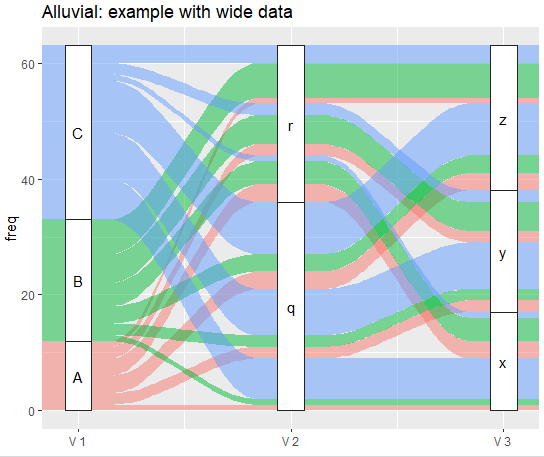Wide format
The data to be displayed can be in a data frame with wide format where one row is stored per alluvium.
library(ggalluvial)
data <- data.frame (
v_1 = c('A', 'A', 'A', 'A', 'A', 'A', 'B', 'B', 'B', 'B', 'B', 'B', 'C', 'C', 'C', 'C', 'C', 'C'),
v_2 = c('q', 'q', 'q', 'r', 'r', 'r', 'q', 'q', 'q', 'r', 'r', 'r', 'q', 'q', 'q', 'r', 'r', 'r'),
v_3 = c('x', 'y', 'z', 'x', 'y', 'z', 'x', 'y', 'z', 'x', 'y', 'z', 'x', 'y', 'z', 'x', 'y', 'z'),
freq = c( 1 , 2 , 3 , 3 , 2 , 1 , 1 , 2 , 3 , 4 , 5 , 6 , 7 , 8 , 9 , 1 , 2 , 3 )
);
ggplot(data,
aes(y = freq,
axis1 = v_1,
axis2 = v_2,
axis3 = v_3
)
) + geom_alluvium(
aes(fill = v_1),
# width = 0,
# knot.pos = 0,
reverse = FALSE
) + guides(
fill = FALSE
) + geom_stratum(
width = 1/8 ,
reverse = FALSE,
color = '#222222'
) + geom_text(
stat = 'stratum',
label.strata = TRUE,
reverse = FALSE
) + scale_x_continuous(
breaks = 1:3,
labels = c('V 1', 'V 2', 'V 3')
#) + coord_flip( # Uncomment to plot from bottom to top
) + ggtitle('Alluvial: example with wide data'
)
Github repository about-r, path: /packages/ggalluvial/wide-format.R
